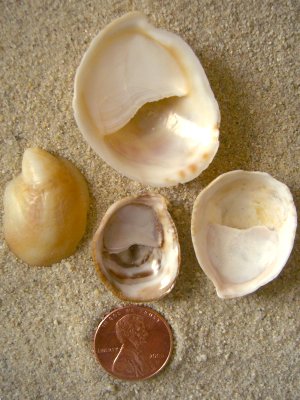
Common Atlantic Slipper Shell
Crepidula fornicata Linnaeus, 1758

Common Atlantic Slipper Shell
Crepidula fornicata Linnaeus, 1758
A favorite of children, the convex “Slipper,” “Boat,” or “Quarterdeck” Shell is easy to identify. It looks like a bedroom slipper because of the white plate which partially covers the cavity.
The plate or partition often has a reddish-brown edge. The plate, or as it has been called, “the deck,” is typically concave with a sinuate or wavy edge. The outer surface of the gastropod may be either smooth or wrinkled. The Common Atlantic Slipper Shell is yellow, creamy, or brownish, often flecked with reddish brown, and can be found from Canada to Texas, and on northwest European shores. The living gastropod inhabits shallow water. The shell grows up to a length of 1½ inches. There is no operculum.
Sometimes the Common Atlantic Slipper Shell is found washed ashore attached to another shell, perhaps an Olive Shell, or even another Crepidula fornicata. The Slipper Shell often lives in stacks or chains since it likes to attach itself to others of its kind. This makes reproduction convenient. The species in the Crepidulidae family are hermaphroditic. During the spawning (or mating) season, they alternate sexes. Eggs are laid (70-100 at a time) in thin-walled capsules which are attached to the substrate (the base on which the creature lives). Common Slipper Shell larvae emerge from these capsules.
Crepidula fornicata may compete with oysters for food and attachment sites in oyster reefs. However, quantities of the shell have been used commercially as an underwater foundation on which oyster embryos can grow. In a splendid work, The Shell Book, written by Julia E. Rogers in 1931, the authoress tells us:
Fishermen at Greenport, Long Island, dredge up the accumulation of dead shells and sell them to oyster growers for “stool.” This means that they are scattered over the rocky floor of new beds for the embryo oysters to settle upon. “Quarter-decks” is the trade name they go by. They are taken with the “jingle shells,” which frequent the same banks, and are also excellent as oyster stool. In 1887 Greenport alone sold 130,000 bushels of the two shells to the oyster growers for $5,200, an average price of four cents per bushel.
English oyster beds are in some places replenished with “seed” from American growers. With these young oysters C. fornicata has been introduced. Conditions are favourable to growth, and the “crow oyster,” as it is called, has become a nuisance. The edible oyster, when overloaded with slippers, often three to six deep, is stunted and unsightly. The parasites rob the oysters of their food, and choke them besides. There seems to be no way of getting the better of the invader.